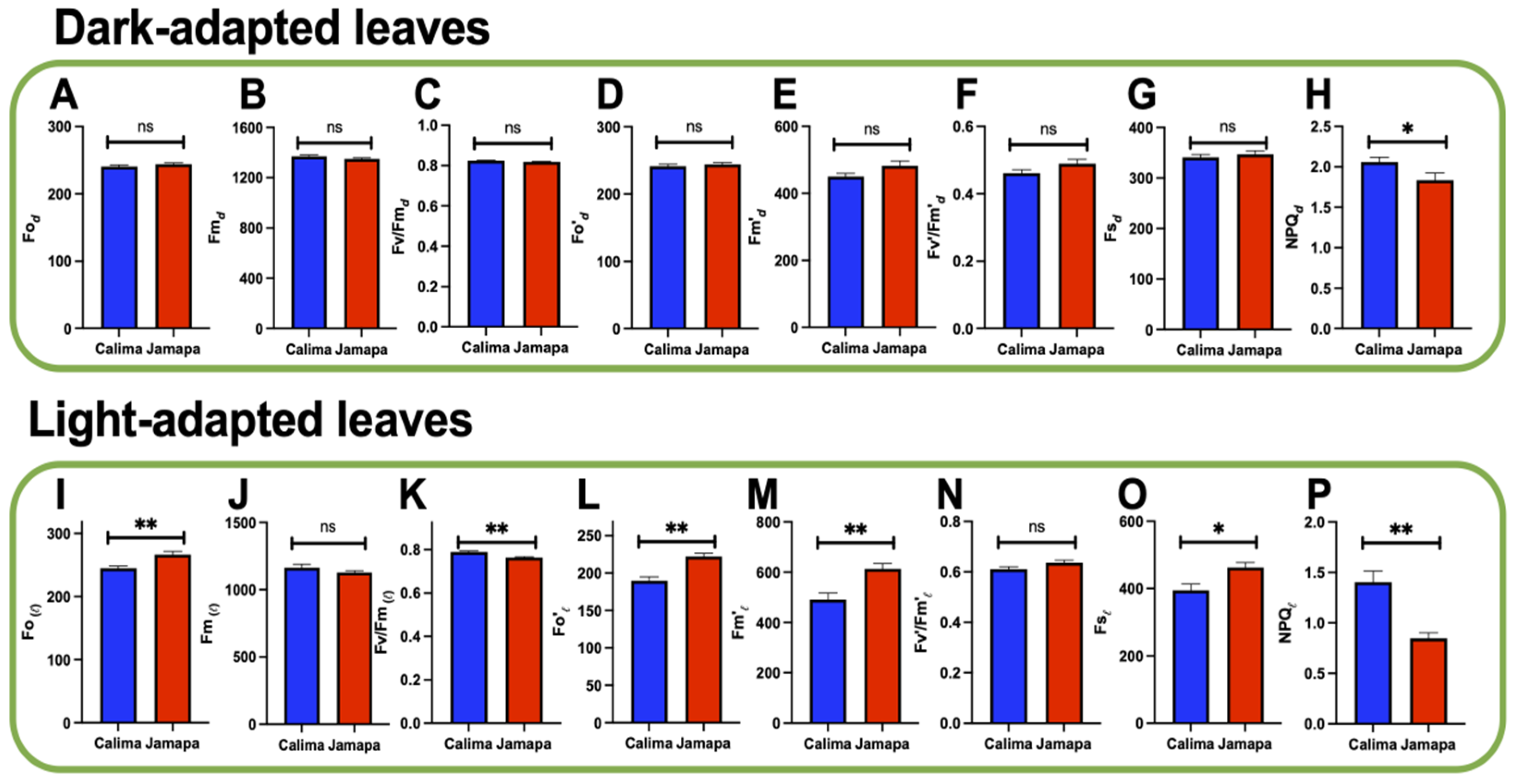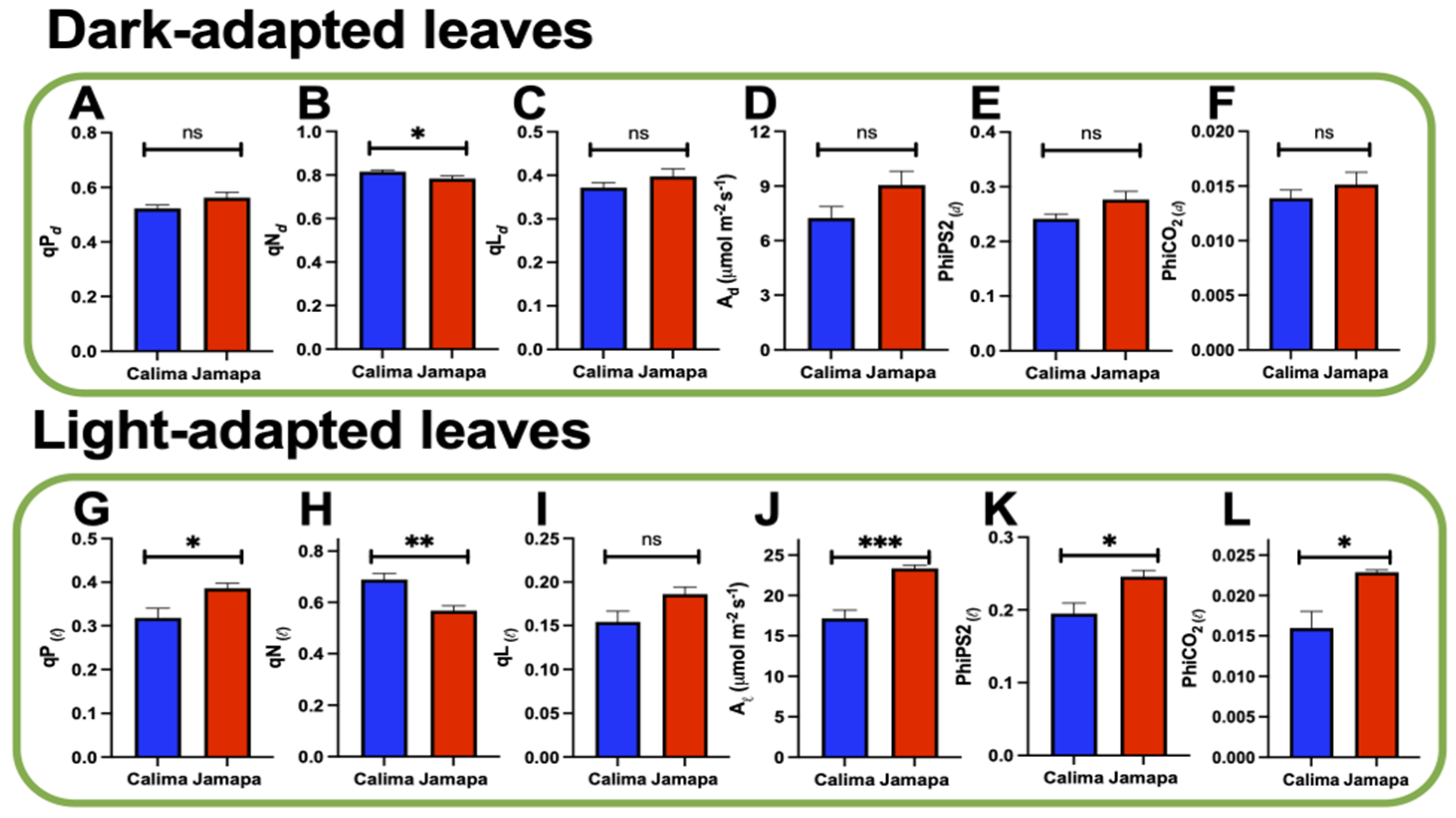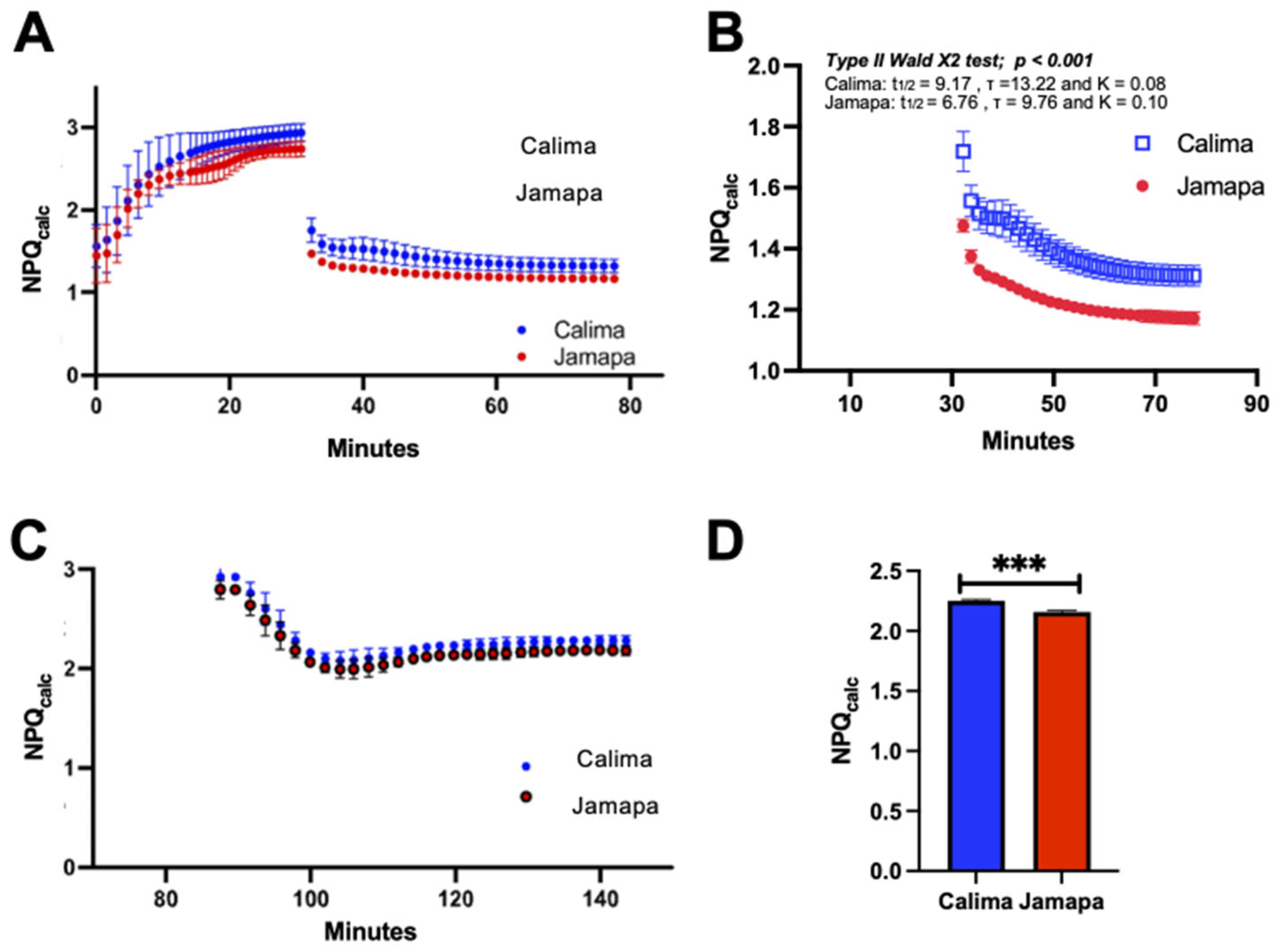Contrasting Dynamic Photoprotective Mechanisms under Fluctuating Light Environments between an Andean and a Mesoamerican Genotype of Phaseolus vulgaris L.
Abstract
1. Introduction
2. Materials and Methods
2.1. Plant Material
2.2. Dark and Light Adaptation of Leaves
2.3. Chlorophyll Fluorescence on Dark-Adapted and Light-Adapted Leaves
2.4. Non-Photochemical Quenching (NPQ) in Fluctuating Light
3. Data Analysis
4. Results
4.1. Variation in Chlorophyll Fluorescence of Dark- and Light-Adapted Leaves between an Andean and a Mesoamerican Common Bean Genotype
4.2. NPQ Induction Patterns in Andean (Calima) and Mesoamerican (Jamapa) Common Bean Genotypes
4.3. NPQ Relaxation in Andean (Calima) and Mesoamerican (Jamapa) Common Bean Genotypes
5. Discussion
6. Conclusions
Supplementary Materials
Author Contributions
Funding
Institutional Review Board Statement
Data Availability Statement
Conflicts of Interest
Abbreviations
| Fo | Minimum fluorescence after dark adaptation |
| Fm | Maximum fluorescence after dark adaptation |
| Fv/Fm | Maximum quantum efficiency of PSII reaction centers after dark adaptation (1 − (Fo/Fm)) |
| Fo′ | Minimum fluorescence after light adaptation |
| Fm′ | Maximum fluorescence after light adaptation |
| Fv′/Fm′ | Effective quantum efficiency of PSII reaction centers of after light adaptation (1 − (Fo′/Fm′)) |
| Fs | Steady-state fluorescence (after light adaptation) |
| ΦPS2 | Quantum efficiency of photosynthetic electron transport through PSII |
| ΦCO2 | Quantum efficiencies of photosynthetic electron transport through CO2 assimilation (ΦCO2/ΦCO2) |
| qP | Photochemical (qP) quenching coefficient |
| qN | Non-photochemical (qN) quenching coefficient |
| qL | Open reaction centers estimated from qP |
| NPQ | Non-photochemical quenching |
| A | CO2 assimilation |
References
- Guidi, L.; Lo Piccolo, E.; Landi, M. Chlorophyll Fluorescence, Photoinhibition and Abiotic Stress: Does It Make Any Difference the Fact to Be a C3 or C4 Species? Front. Plant Sci. 2019, 10, 174. [Google Scholar] [CrossRef] [PubMed]
- Kaiser, E.; Correa Galvis, V.; Armbruster, U. Efficient Photosynthesis in Dynamic Light Environments: A Chloroplast’s Perspective. Biochem. J. 2019, 476, 2725–2741. [Google Scholar] [CrossRef] [PubMed]
- Kress, E.; Jahns, P. The Dynamics of Energy Dissipation and Xanthophyll Conversion in Arabidopsis Indicate an Indirect Photoprotective Role of Zeaxanthin in Slowly Inducible and Relaxing Components of Non-Photochemical Quenching of Excitation Energy. Front. Plant Sci. 2017, 8, 2094. [Google Scholar] [CrossRef] [PubMed]
- Ware, M.A.; Belgio, E.; Ruban, A.V. Photoprotective Capacity of Non-Photochemical Quenching in Plants Acclimated to Different Light Intensities. Photosynth. Res. 2015, 126, 261–274. [Google Scholar] [CrossRef]
- Kromdijk, J.; Głowacka, K.; Leonelli, L.; Gabilly, S.T.; Iwai, M.; Niyogi, K.K.; Long, S.P. Improving Photosynthesis and Crop Productivity by Accelerating Recovery from Photoprotection. Science 2016, 354, 857–861. [Google Scholar] [CrossRef] [PubMed]
- Ruban, A.V. Nonphotochemical Chlorophyll Fluorescence Quenching: Mechanism and Effectiveness in Protecting Plants from Photodamage. Plant Physiol. 2016, 170, 1903–1916. [Google Scholar] [CrossRef]
- Papageorgiou, G.C.; Govindjee (Eds.) Chlorophyll a Fluorescence: A Signature of Photosynthesis; Advances in Photosynthesis and Respiration; Springer: Dordrecht, The Netherlands, 2004; Volume 19, ISBN 978-1-4020-3217-2. [Google Scholar]
- Tikkanen, M.; Mekala, N.R.; Aro, E.-M. Photosystem II Photoinhibition-Repair Cycle Protects Photosystem I from Irreversible Damage. Biochim. Biophys. Acta BBA Bioenerg. 2014, 1837, 210–215. [Google Scholar] [CrossRef]
- Goh, C.-H.; Ko, S.-M.; Koh, S.; Kim, Y.-J.; Bae, H.-J. Photosynthesis and Environments: Photoinhibition and Repair Mechanisms in Plants. J. Plant Biol. 2012, 55, 93–101. [Google Scholar] [CrossRef]
- Huang, W.; Yang, Y.-J.; Hu, H.; Zhang, S.-B. Different Roles of Cyclic Electron Flow around Photosystem I under Sub-Saturating and Saturating Light Intensities in Tobacco Leaves. Front. Plant Sci. 2015, 6, 923. [Google Scholar] [CrossRef]
- Zaks, J.; Amarnath, K.; Kramer, D.M.; Niyogi, K.K.; Fleming, G.R. A Kinetic Model of Rapidly Reversible Nonphotochemical Quenching. Proc. Natl. Acad. Sci. USA 2012, 109, 15757–15762. [Google Scholar] [CrossRef]
- Nilkens, M.; Kress, E.; Lambrev, P.; Miloslavina, Y.; Müller, M.; Holzwarth, A.R.; Jahns, P. Identification of a Slowly Inducible Zeaxanthin-Dependent Component of Non-Photochemical Quenching of Chlorophyll Fluorescence Generated under Steady-State Conditions in Arabidopsis. Biochim. Biophys. Acta BBA Bioenerg. 2010, 1797, 466–475. [Google Scholar] [CrossRef] [PubMed]
- Lu, D.; Zhang, Y.; Zhang, A.; Lu, C. Non-Photochemical Quenching: From Light Perception to Photoprotective Gene Expression. Int. J. Mol. Sci. 2022, 23, 687. [Google Scholar] [CrossRef] [PubMed]
- Jahns, P.; Holzwarth, A.R. The Role of the Xanthophyll Cycle and of Lutein in Photoprotection of Photosystem II. Biochim. Biophys. Acta BBA Bioenerg. 2012, 1817, 182–193. [Google Scholar] [CrossRef] [PubMed]
- Takahashi, S.; Milward, S.E.; Fan, D.-Y.; Chow, W.S.; Badger, M.R. How Does Cyclic Electron Flow Alleviate Photoinhibition in Arabidopsis? Plant Physiol. 2009, 149, 1560–1567. [Google Scholar] [CrossRef] [PubMed]
- Murchie, E.H.; Ruban, A.V. Dynamic Non-photochemical Quenching in Plants: From Molecular Mechanism to Productivity. Plant J. 2020, 101, 885–896. [Google Scholar] [CrossRef]
- Ruban, A.V.; Johnson, M.P. Dynamics of Higher Plant Photosystem Cross-Section Associated with State Transitions. Photosynth. Res. 2009, 99, 173–183. [Google Scholar] [CrossRef]
- Roach, T.; Na, C.S. LHCSR3 Affects De-Coupling and Re-Coupling of LHCII to PSII during State Transitions in Chlamydomonas Reinhardtii. Sci. Rep. 2017, 7, 43145. [Google Scholar] [CrossRef] [PubMed]
- Avenson, T.J.; Cruz, J.A.; Kramer, D.M. Modulation of Energy-Dependent Quenching of Excitons in Antennae of Higher Plants. Proc. Natl. Acad. Sci. USA 2004, 101, 5530–5535. [Google Scholar] [CrossRef]
- Juneau, P.; Green, B.R.; Harrison, P.J. Simulation of Pulse-Amplitude-Modulated (PAM) Fluorescence: Limitations of Some PAM-Parameters in Studying Environmental Stress Effects. Photosynthetica 2005, 43, 75–83. [Google Scholar] [CrossRef]
- Zuo, G.; Aiken, R.M.; Feng, N.; Zheng, D.; Zhao, H.; Avenson, T.J.; Lin, X. Fresh Perspectives on an Established Technique: Pulsed Amplitude Modulation Chlorophyll a Fluorescence. Plant-Environ. Interact. 2022, 3, 41–59. [Google Scholar] [CrossRef]
- LI-COR, Biosciences. Using the Li-6800 Portable Photosynthesis System; LI-COR, Biosciences: Lincoln, NE, USA, 2023; Available online: https://www.licor.com/env/support/MicroContent/Resources/MicroContent/manuals/li-6800-instruction-manual.html (accessed on 28 July 2024).
- Armbruster, U.; Carrillo, L.R.; Venema, K.; Pavlovic, L.; Schmidtmann, E.; Kornfeld, A.; Jahns, P.; Berry, J.A.; Kramer, D.M.; Jonikas, M.C. Ion Antiport Accelerates Photosynthetic Acclimation in Fluctuating Light Environments. Nat. Commun. 2014, 5, 5439. [Google Scholar] [CrossRef] [PubMed]
- Zhu, X.; Ort, D.R.; Whitmarsh, J.; Long, S.P. The Slow Reversibility of Photosystem II Thermal Energy Dissipation on Transfer from High to Low Light May Cause Large Losses in Carbon Gain by Crop Canopies: A Theoretical Analysis. J. Exp. Bot. 2004, 55, 1167–1175. [Google Scholar] [CrossRef]
- Kaiser, E.; Morales, A.; Harbinson, J. Fluctuating Light Takes Crop Photosynthesis on a Rollercoaster Ride. Plant Physiol. 2018, 176, 977–989. [Google Scholar] [CrossRef]
- White, J.W.; Kornegay, J.; Castillo, J.; Molano, C.H.; Cajiao, C.; Tejada, G. Effect of Growth Habit on Yield of Large-Seeded Bush Cultivars of Common Bean. Field Crops Res. 1992, 29, 151–161. [Google Scholar] [CrossRef]
- Weller, J.L.; Vander Schoor, J.K.; Perez-Wright, E.C.; Hecht, V.; González, A.M.; Capel, C.; Yuste-Lisbona, F.J.; Lozano, R.; Santalla, M. Parallel Origins of Photoperiod Adaptation Following Dual Domestications of Common Bean. J. Exp. Bot. 2019, 70, 1209–1219. [Google Scholar] [CrossRef]
- Clavijo Michelangeli, J.A.; Bhakta, M.; Gezan, S.A.; Boote, K.J.; Vallejos, C.E. From Flower to Seed: Identifying Phenological Markers and Reliable Growth Functions to Model Reproductive Development in the Common Bean (Phaseolus Vulgaris L.). Plant Cell Environ. 2013, 36, 2046–2058. [Google Scholar] [CrossRef]
- Bhakta, M.S.; Gezan, S.A.; Clavijo Michelangeli, J.A.; Carvalho, M.; Zhang, L.; Jones, J.W.; Boote, K.J.; Correll, M.J.; Beaver, J.; Osorno, J.M.; et al. A Predictive Model for Time-to-Flowering in the Common Bean Based on QTL and Environmental Variables. G3 GenesGenomesGenetics 2017, 7, 3901–3912. [Google Scholar] [CrossRef] [PubMed]
- Zhang, L.; Gezan, S.A.; Eduardo Vallejos, C.; Jones, J.W.; Boote, K.J.; Clavijo-Michelangeli, J.A.; Bhakta, M.; Osorno, J.M.; Rao, I.; Beebe, S.; et al. Development of a QTL-Environment-Based Predictive Model for Node Addition Rate in Common Bean. Theor. Appl. Genet. 2017, 130, 1065–1079. [Google Scholar] [CrossRef]
- Egesa, A.O.; Vallejos, C.E.; Begcy, K. Cell Size Differences Affect Photosynthetic Capacity in a Mesoamerican and an Andean Genotype of Phaseolus vulgaris L. Front. Plant Sci. 2024, 15, 1422814. [Google Scholar] [CrossRef]
- Bhakta, M.S.; Jones, V.A.; Vallejos, C.E. Punctuated Distribution of Recombination Hotspots and Demarcation of Pericentromeric Regions in Phaseolus vulgaris L. PLoS ONE 2015, 10, e0116822. [Google Scholar] [CrossRef]
- Laĭsk, A.K.; Nedbal, L.; Govindjee (Eds.) Photosynthesis in Silico: Understanding Complexity from Molecules to Ecosystems; Advances in photosynthesis and respiration; Springer: Dordrecht, The Netherlands, 2009; ISBN 978-1-4020-9236-7. [Google Scholar]
- Kramer, D.M.; Johnson, G.; Kiirats, O.; Edwards, G.E. New Fluorescence Parameters for the Determination of QA Redox State and Excitation Energy Fluxes. Photosynth. Res. 2004, 79, 209–218. [Google Scholar] [CrossRef]
- R Core Team R: A Language and Environment for Statistical Computing 2021. Available online: https://www.r-project.org/ (accessed on 20 January 2024).
- Bilger, W.; Björkman, O. Role of the Xanthophyll Cycle in Photoprotection Elucidated by Measurements of Light-Induced Absorbance Changes, Fluorescence and Photosynthesis in Leaves of Hedera Canariensis. Photosynth. Res. 1990, 25, 173–185. [Google Scholar] [CrossRef] [PubMed]
- Hendrickson, L.; Furbank, R.T.; Chow, W.S. A Simple Alternative Approach to Assessing the Fate of Absorbed Light Energy Using Chlorophyll Fluorescence. Photosynth. Res. 2004, 82, 73–81. [Google Scholar] [CrossRef]
- Knopf, O.; Castro, A.; Bendig, J.; Pude, R.; Kleist, E.; Poorter, H.; Rascher, U.; Muller, O. Field Phenotyping of Ten Wheat Cultivars under Elevated CO2 Shows Seasonal Differences in Chlorophyll Fluorescence, Plant Height and Vegetation Indices. Front. Plant Sci. 2024, 14, 1304751. [Google Scholar] [CrossRef] [PubMed]
- Cardona, T.; Shao, S.; Nixon, P.J. Enhancing Photosynthesis in Plants: The Light Reactions. Essays Biochem. 2018, 62, 85–94. [Google Scholar] [CrossRef]
- Nicol, L.; Nawrocki, W.J.; Croce, R. Disentangling the Sites of Non-Photochemical Quenching in Vascular Plants. Nat. Plants 2019, 5, 1177–1183. [Google Scholar] [CrossRef] [PubMed]
- Cejudo, F.J.; Ojeda, V.; Delgado-Requerey, V.; González, M.; Pérez-Ruiz, J.M. Chloroplast Redox Regulatory Mechanisms in Plant Adaptation to Light and Darkness. Front. Plant Sci. 2019, 10, 380. [Google Scholar] [CrossRef]
- Takahashi, H.; Watanabe, A.; Tanaka, A.; Hashida, S.; Kawai-Yamada, M.; Sonoike, K.; Uchimiya, H. Chloroplast NAD Kinase Is Essential for Energy Transduction Through the Xanthophyll Cycle in Photosynthesis. Plant Cell Physiol. 2006, 47, 1678–1682. [Google Scholar] [CrossRef][Green Version]
- Armbruster, U.; Leonelli, L.; Correa Galvis, V.; Strand, D.; Quinn, E.H.; Jonikas, M.C.; Niyogi, K.K. Regulation and Levels of the Thylakoid K+/H+ Antiporter KEA3 Shape the Dynamic Response of Photosynthesis in Fluctuating Light. Plant Cell Physiol. 2016, 57, 1557–1567. [Google Scholar] [CrossRef]




| NPQ * | 1000 µmol m−2s−1 PAR | 1500 µmol m−2s−1 PAR | 2000 µmol m−2s−1 PAR | |||||||||
| Genotype | Slope = ∆NPQ/∆t (min) | R2 | r | p-value | Slope = ∆NPQ/∆t (min) | R2 | r | p-value | Slope = ∆NPQ/∆t (min) | R2 | r | p-value |
| Calima | 0.039 | 0.56 | 0.75 | 0.001 | 0.012 | 0.04 | 0.19 | >0.05 | 0.028 | 0.1 | 0.3 | >0.05 |
| Jamapa | −0.0029 | 0.01 | −0.08 | >0.05 | 0.018 | 0.12 | 0.34 | >0.05 | 0.013 | 0.07 | 0.26 | >0.05 |
| Assimilation | 1000 µmol m−2s−1 PAR | 1500 µmol m−2s−1 PAR | 2000 µmol m−2s−1 PAR | |||||||||
| Genotype | Slope = ∆A/∆t (min) | R2 | r | p-value | Slope = ∆A/∆t (min) | R2 | r | p-value | Slope = ∆A/∆t (min) | R2 | r | p-value |
| Calima | −0.08 | 0.02 | −0.14 | >0.05 | 0.23 | 0.78 | 0.88 | 0.05 | 0.28 | 0.2 | 0.44 | >0.05 |
| Jamapa | 0.03 | 0.01 | −0.08 | >0.05 | 0.2 | 0.06 | 0.25 | >0.05 | 0.03 | 0.06 | 0.05 | >0.05 |
Disclaimer/Publisher’s Note: The statements, opinions and data contained in all publications are solely those of the individual author(s) and contributor(s) and not of MDPI and/or the editor(s). MDPI and/or the editor(s) disclaim responsibility for any injury to people or property resulting from any ideas, methods, instructions or products referred to in the content. |
© 2024 by the authors. Licensee MDPI, Basel, Switzerland. This article is an open access article distributed under the terms and conditions of the Creative Commons Attribution (CC BY) license (https://creativecommons.org/licenses/by/4.0/).
Share and Cite
Egesa, A.O.; Puengchanchaikul, V.; Vallejos, C.E.; Begcy, K. Contrasting Dynamic Photoprotective Mechanisms under Fluctuating Light Environments between an Andean and a Mesoamerican Genotype of Phaseolus vulgaris L. Agronomy 2024, 14, 1907. https://doi.org/10.3390/agronomy14091907
Egesa AO, Puengchanchaikul V, Vallejos CE, Begcy K. Contrasting Dynamic Photoprotective Mechanisms under Fluctuating Light Environments between an Andean and a Mesoamerican Genotype of Phaseolus vulgaris L. Agronomy. 2024; 14(9):1907. https://doi.org/10.3390/agronomy14091907
Chicago/Turabian StyleEgesa, Andrew Ogolla, Voraruthai Puengchanchaikul, C. Eduardo Vallejos, and Kevin Begcy. 2024. "Contrasting Dynamic Photoprotective Mechanisms under Fluctuating Light Environments between an Andean and a Mesoamerican Genotype of Phaseolus vulgaris L." Agronomy 14, no. 9: 1907. https://doi.org/10.3390/agronomy14091907
APA StyleEgesa, A. O., Puengchanchaikul, V., Vallejos, C. E., & Begcy, K. (2024). Contrasting Dynamic Photoprotective Mechanisms under Fluctuating Light Environments between an Andean and a Mesoamerican Genotype of Phaseolus vulgaris L. Agronomy, 14(9), 1907. https://doi.org/10.3390/agronomy14091907






